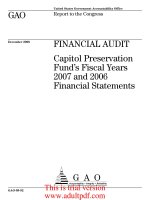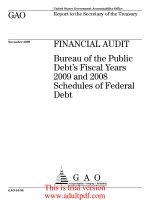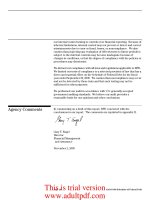United States Government Accountability Office GAO November 2008 Report to the Chairman, United States Securities and Exchange Commission_part3 potx
Bạn đang xem bản rút gọn của tài liệu. Xem và tải ngay bản đầy đủ của tài liệu tại đây (45.72 KB, 1 trang )
Management’s Discussion and Analysis
Page 19 GAO-09-173 SEC’s Financial Statements for Fiscal Years 2008 and 2007
Management’s Discussion and Analysis
11
unanimously to require weekly reporting by hedge funds
and other large investment managers of their daily short
positions, as part of a comprehensive investigation of
possible market manipulation.
Guidance to support money market funds. In
September 2008, the Offi ce of the Chief Accountant
(OCA) provided guidance to clarify how banks should
treat, for purposes of their balance sheets, the fi nancial
support they provide to money market funds within the
same fi nancial services complex. This helped clarify for
banks the appropriate accounting treatment for any
assistance they render to money market funds, helping
to protect investors in these funds.
Guidance on fair value accounting. The credit
market crisis that deepened in September 2008 made
questions about the determination of fair value particu-
larly challenging for preparers, auditors, and users of
fi nancial information, as the concept of fair value mea-
surement assumes an orderly transaction between market
participants. OCA and the Financial Accounting Standards
Board (FASB) jointly provided timely clarifi cation, based on
the guidance issued by OCA and FASB staff in FASB
Statement No. 157, Fair Value Measurements. The clarifi -
cation addressed questions cited as most urgent while the
FASB prepared to propose additional interpretative
guidance on fair value measurement under U.S. generally
accepted accounting principles (GAAP). Among other
issues, OCA and FASB addressed the use of manage-
ment’s internal assumptions and broker quotes to
measure fair value when an active market for a security
does not exist.
Study on fair value accounting. The Emergency
Economic Stabilization Act of 2008 called for the SEC to
conduct a study of mark-to-market accounting standards,
considering the effects of such standards on the balance
sheets of fi nancial institutions, on bank failures in 2008,
and on the quality of fi nancial information available to
investors. The agency has dedicated substantial resources
to this study.
Implementation of the Troubled Asset Relief Program.
The Chairman serves as one of fi ve members of the Financial
Stability Oversight Board, which oversees the U.S. Department
of the Treasury’s (Treasury) implementation of the $700 billion
Troubled Asset Relief Program. The SEC brings to this role its
unique perspective on investor protection, the maintenance of
orderly markets, and the promotion of capital formation.
Regulation of credit rating agencies. The Commission
began regulating credit rating agencies in the last month
of FY 2007. In FY 2008 the agency examined the three
largest rating agencies. These examinations uncovered
serious shortcomings at these fi rms, including a lack of
disclosure to investors and the public, a lack of policies and
procedures to manage the rating process, and insuffi cient
attention to confl icts of interest. The rating agencies all
agreed to implement broad reforms to address these
problems. In addition, the Commission proposed sweeping
new rules for rating agencies to bring increased transpar-
ency to the credit ratings process and curb practices that
contributed to the turmoil in the credit markets. The rules
are designed to improve investor understanding of credit
ratings through enhanced disclosure of the agencies’
methods and performance data, reduce undue reliance on
credit ratings, and promote investor confi dence in credit
ratings by minimizing confl icts of interest.
Formal Cooperation with the Federal Reserve
Board. In July 2008, the SEC signed a Memorandum of
Understanding with the Federal Reserve Board to cooperate
and share information related to anti-money laundering,
bank brokerage activities under the Gramm-Leach-Bliley Act,
clearance and settlement in the banking and securities
industries, the regulation of transfer agents, and other key
areas. In addition to giving both organizations continued
insight during the deepening credit crisis, the memorandum
also enhanced SEC oversight of the broker-dealer subsidiaries
of bank holding companies. The information from the bank
holding company level that the SEC now receives under the
memorandum will strengthen the agency’s ability to protect
the customers of the broker-dealers and the integrity of the
broker-dealer fi rms.
Ending the CSE Program. The Consolidated Supervised
Entities (CSE) program was created in 2004 in an effort to fi ll
a regulatory hole regarding the lack of oversight for major
investment bank holding companies under the Gramm-
Leach-Bliley Act of 1999. Due to the lack of statutory
authority from Congress, however, the program was
voluntary in nature. In addition, the program’s use of the
Basel standards for holding company capital and the Federal
Reserve’s 10 percent “well capitalized” standard was found
inadequate when Bear Stearns nearly failed in March 2008.
The SEC ended the voluntary CSE program in September
2008. Broker-dealer subsidiaries of former participants in the
program continue to be monitored vigorously.
This is trial version
www.adultpdf.com









